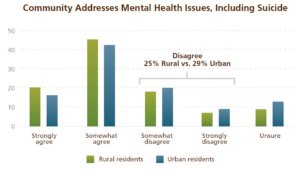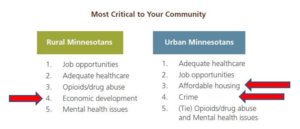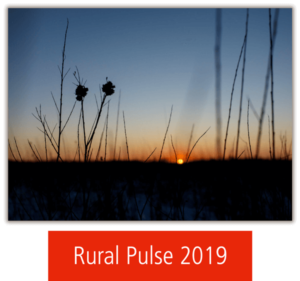 Image: Blog hero Plant Plate 09 boys dig in
Image: Blog hero Plant Plate 09 boys dig in
Rural Pulse 2019: The Pulse captures the complexity of Minnesota

by Jennifer Bevis Posted in Tools You Can Use
Minnesota is often simplistically framed as “the metro” and “Greater Minnesota” — two distinct, sometimes divided, districts.
Dig deeper, though, and that picture becomes a mosaic. People and places, environments and economies are intertwined. We are a rich tapestry, each component critical to completing the whole.
For a snapshot of that complexity – and a close-up of how rural fits into the picture – consider Rural Pulse.
The Rural Pulse survey – which you can always find at www.ruralpulse.org — has tracked rural residents’ perspectives since 1998. The most recent edition, commissioned in 2019 by Blandin Foundation and conducted by Russell Herder, gauges Minnesotans’ perceptions of issues facing rural Minnesota communities. More than 2,660 rural and urban Minnesotans participated this time around.
Thanks to candid feedback, Rural Pulse offers a way to explore different perspectives, provides insights to fuel conversations, and raises up differences that may make a difference.
Common ground: strong local economies, wanting more on mental health
Rural Pulse tracks results for one Minnesota’s most obvious differences: rural and urban communities (we define “urban” as having populations greater than 35,000). In 2019, both rural and urban folks share a belief that local economies are getting stronger, and that our communities can do better on addressing mental health issues.


Contrasts: good jobs, which issues matter most
Though they say their local economy is stronger, rural residents also say their communities could do better in having enough good jobs – as they have for several years, and across all regions of rural Minnesota. Urban residents have been more satisfied on this front over the years.
The short-list of issues most critical for communities looks fairly similar across rural and urban, with a couple of interesting exceptions.


Surprises in migration
This year’s Pulse also yielded some surprises – including, for the first time, a sense that rural folks are staying put, while metro folks are more interested in moving to less populated areas. We’ll cover these surprises in future posts, but here’s a taste.

Put the Pulse to work for you
Rural Pulse comes alive when people use it. How can this information benefit your work?
Bring it to work – these charts are not just for elected leaders, economic development professionals, or academic researchers (though we know they’ll also find them valuable.) Teachers, people who work in day cares and youth programs, business owners, volunteers at church and community groups, champions of hunger or housing – all will find useful information here.
Start a conversation – it can be as quick as pinging your pals when you see startling data in our Facebook or Twitter feeds. Bring a cool chart to your next meeting – of staff, Boy Scouts, your union, even your family. Find out what these folks see in the data, and what you can do with it.
Get things started with questions like:
- What do you notice in this chart?
- How does it match – or not – with what you know about your community? Why?
- In what ways is your community working on this topic?
- Who else could we share this with?
Return again and again – we build Rural Pulse for the long haul. In our experience, it can be a resource for you and your networks for a long time to come.
Ask us for a guided tour – we’ll be glad to walk you through the data, and answer any questions you have. We may also consider presentations to groups or organizations with regional scope. Start by emailing Allison, our communications director.
With gratitude – If you’re one of the 2,660 people who took the survey – thank you! We value your time, are eager to share these results with you, and look forward to hearing from you if you have additional thoughts.
We believe that informed people working together toward a common vision propel community change. In other words: thank you for all you do to design and claim a vibrant, resilient future for your community! We stand with you in that important work. Put Rural Pulse to work for you!
Primer on the Pulse
We’ve built Rural Pulse as a family of reports, so the data is easier to digest and put to work.
 Rural data – true to our original intent, Rural Pulse captures and calls attention to issues and priorities on the minds of rural Minnesota leaders and residents. Though rural Minnesotans may be outnumbered, Blandin Foundation believes these voices and perspectives must not be left out of conversations about policies and resources.
Rural data – true to our original intent, Rural Pulse captures and calls attention to issues and priorities on the minds of rural Minnesota leaders and residents. Though rural Minnesotans may be outnumbered, Blandin Foundation believes these voices and perspectives must not be left out of conversations about policies and resources.
Rural/urban comparison: shows where we have common ground (there’s a fair amount!) and where differences shape our perceptions and priorities. Many thanks to the St. Paul and Minnesota Foundations for their support of the urban resident portion of Rural Pulse. (And if you’re interested, they’ve recently released the East Metro Pulse survey of the St. Paul area.)
Regional reports – show what’s happening across all six regions of rural Minnesota.
Community dimensions reports – insights around Blandin Foundation’s 9 Dimensions of a Healthy Community, from environment to spirituality and wellness.
Special reports – deeper dives in sectors of rural: our leadership program alumni, home giving area, and cultural groups.
Sign Up for E-News
Subscribe to our periodic newsletter for updates and opportunities about vibrant rural Minnesota.